#o'neill cylinder
Explore tagged Tumblr posts
Text
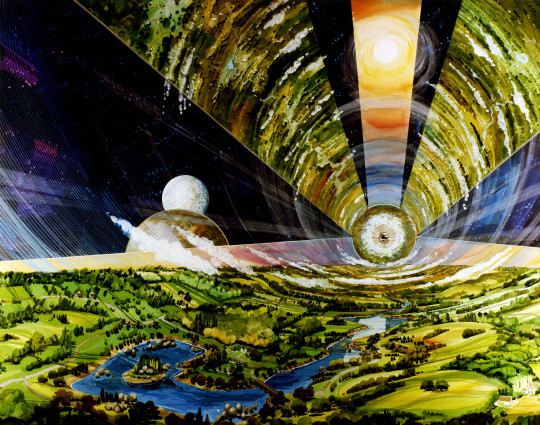
Rick Guidice, 1974.
(MoMA)
596 notes
·
View notes
Text


"Crabs" and their tin cans
Just some mostly finished artwork for a superhero story I'm ~trying~ to write, don't count on it ever coming out. While I have yet to name these crustacean-like sophonts, they'll play a very important part of the story, with the narrative being split between humans, more specifically the one turned into a superman stand in (that weighs a good fraction of a gigaton), and well, these things, more specifically a girl attempting to be a masked vigilant.
The world of these "lobsters" orbits an ancient F-class star, putting their planet at the tail end of supporting complex multicellular life... they're used to the "shitty" environment. not that any of them are particularly worried, their planet's still habitable for another 150ish million earth years and they could easily leave within that time frame... they got O'Neill Cylinders ffs.
will try to add docking ports at some point
@jellynyann @the-real-loser-otaku-girl @ki-2-your-heart @tearykitten @a0rt-a @bladeechan @
Also, they're parasitoids heavily inspired by the "vertebrates" from "Snaiad" (C.M. Kosemen), so y'all can probably figure out what the black tips of females are.
#my art#blender#low poly#scifi#scifiart#spec evo#hard sci fi#hard science fiction#alien#pixel art#pixel graphics#original comic#web comic#manga inspired#megastructure#o'neill cylinder#rotating space habitat#speculative biology
21 notes
·
View notes
Text

When you read the Colonization of Space paper by Gerard O'Neill and it suddenly all makes sense
14 notes
·
View notes
Text

Loop Town Dawn Digital artwork by me, 2022
#art#artists on tumblr#artwork#digitalart#noir#film noir#scifi#scifi art#cityscape#space station#detective#surreal#surreal art#o'neill cylinder#city#dawn#morning#black and white art#scifi noir#futurism
9 notes
·
View notes
Text

The capital city of New Babel's 1st ring.
#concept art#scifi art#space habitat#oneill cylinder#o'neill cylinder#my art#digital painting#bg paint#krita#environment#𝕿𝖍𝖊 𝕾𝖎𝖓𝖌𝖚𝖑𝖆𝖗𝖎𝖙𝖞.
5 notes
·
View notes
Photo
Rendezvous with Rama!
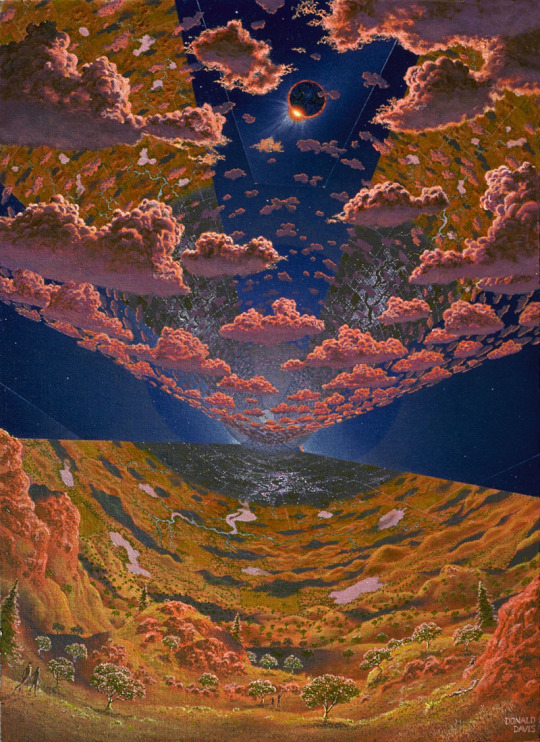
“One of my earliest Space Colony paintings was based on the giant ‘Model 3’ cylindrical habitats envisioned by Gerard O'Neill. I imagined the clouds forming at an ‘altitude’ around the rotation axis.” ~artist Don Davis
#space colony#space habitat#Don Davis#space station#O'Neill cylinder#sci fi#space#spaceship art#surrealism
12K notes
·
View notes
Text

Space Colony by Mitsuki Nakamura
272 notes
·
View notes
Text
There are models for the proposed terraforming of Mars which involve the use of lichens and similar organisms to transform the soil and atmosphere. There's something fascinating about entire strains of living things reproducing and dying for the sake of humanity's own propagation. This is the reduction of entire species of life to a sort of instrumentalism, and there is a horror to that.
There is a (primarily but not exclusively american) cultural cohort who I will call for the purposes of this list the astro-futurists. They are strong proponents of space colonization, frequently for the purposes of building humanity's resilience against supposed "x-risks", such as asteroid strikes or sapient computers that we are unable to control. Even if Earth dies, humanity will live on on martian soil and around the stars of Alpha Centauri!
There is a certain type of high school 'nihilist' who has no philosophical groundings for his works, but has a primitive understanding of Darwinism, and so concludes that the purpose of all life is to reproduce. In the most base sense, he is correct; all extant life is shaped by the need to pass on its genetic material. Most people would say this is reductive, however, and they are correct too.
The lichen would not be the first thing humanity has bent to specific purposes like that. Billions of chickens are kept in factory farms for the sake of meat and egg production, and so their lives are similarly reduced to a singular purpose in the service of humanity. In the reductive eyes of the high schooler, who views procreation as the highest virtue of life, humanity has done these chickens a great favour! While disease and predators might threaten populations of junglefowl in the wild, the structure of the farm protects the chickens from predators, and judicious cullings ensure that some part of the population will always be resilient against disease. Even as humanity kills the chickens for their meat, we ensure that there will always be another chicken.
The chicken is, therefore, the immortal junglefowl. Bar a vast reorganization of human civilization, the domestic chicken will last as long as humanity does. The genes which distinguish them from their wild relatives will propagate forever, just as the lichens humanity plants in the martian soil will have a monopoly on that soil, free of the rival strains of lichen which populate the earth. No one, however, looks at a factory farm and says "How charitable of humanity to make these birds immortal!" Why is this?
The most existentially concerned of the astro-futurists might consider the cultural and social development of space travel, like their more idealistic peers, but ultimately their prerogative is the survival of humanity against any threat which might render Earth uninhabitable. Some have criticized these efforts as a new form of colonialism to further enrich the global north, and note that the countries most capable of creating space colonies are those mostly strongly integrated into the capitalist system. The first flag on Mars will in all likelihood be that of the United States, or that of whichever ascendant capitalist power who succeeds them.
There are two problems with the existential programme of the astro-futurists, beyond the ways in which it unduly advantages the global north. The first is that Mars, and indeed much of space, is a terrible home for humans. Those who live there will suffer from radiation, and poisonous dust, and will likely reside in cramped underground dwellings. The lower gravity will cause their bones and flesh to atrophy, and should they have children on Mars, there is a good chance their young will never return to the home of their parents, lest Earth's gravity crush their feeble lungs and hearts. These lives will be bold and novel, entirely distinct from those of all humans before them, but they may not be enviable.
The second problem is that, even assuming that Mars somehow becomes wholly self-sufficient of Earth, in the event that Earth is destroyed, Mars will not save humanity. A narrow slice of the cultures of the global north will be salvaged by the Martians, perhaps. English will still be spoken, but the hundreds of languages of Africa will likely perish. Recorded music will survive, but the little regional songs no one thought to record will not. This is the survival of humans, not of humanity.
The notion of 'memes' is sometimes attributed to Richard Dawkins, a man with a complicated legacy not worth discussing. I have heard rumour that the idea originates from somewhere else, however. If one takes the traditional formation of memes to be true, then astro-futurism can be considered a sort of meme or collection there, as can its more existentially-concerned strains. If we settle Mars to survive the loss of Earth, then perhaps humanity will die and this meme will continue to propagate. What remains will become another example of the instrumentalization of life, with a vast complexity of experiences reduced, ultimately, to the ability to serve the propagation of others.
#just some ideas#perhaps this is what i believe#perhaps not#i do hope we get up an o'neill cylinder in my lifetime#but i very much doubt we will
11 notes
·
View notes
Text
"With rail service to NEOM" Is code for "completely impractical and unachievable concept that only serves as a futile attempt to restore public image"
#free palestine#the ai render makes this thing look like it was built in an o'neill cylinder#DEEPLY unserious plan
1 note
·
View note
Text
Sunsets in O'Neill colonies have the opportunity to be so dramatic, in ways that they aren't on planets. You could paint the lands above with selective twilight for advertising or pretty patterns, or leave one mirror broken just to fuck with everyone living in one specific city block.

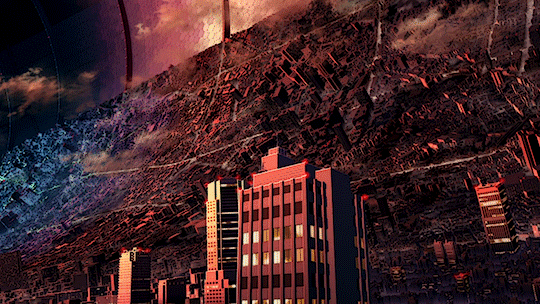
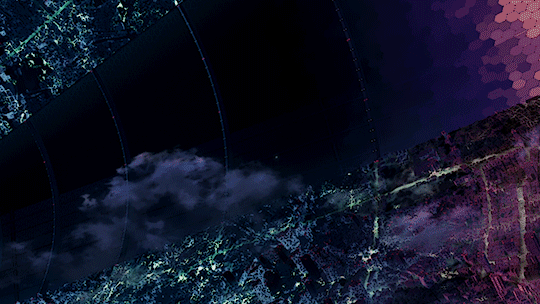
107 notes
·
View notes
Text
Hey folks! I'm crowdfunding a reprint of Hard Wired Island, my cyberpunk TTRPG. Backers can get a discounted physical copy or just a PDF!
Hard Wired Island is a retrofuture cyberpunk game, inspired by 90s anime. It's set on a space station orbiting Earth in an alternate 2020 where a meteorite strike supercharged public interest in space exploration. The player characters are regular Grand Cross citizens doing their best to live their everyday lives while fighting for the station's future.
This 400-page game includes:
An easy-to-learn system where social actions and problem-solving skills are at least as important as hacking and getting into fights.
An alternate 2020 setting in an O'Neill cylinder near Earth.
Descriptions of the many locations of Grand Cross, from the busy downtown Voyager Ward to the high-tech parkland of Mariposa to the Agriculture Ring that feeds the station.
Seven Occupations, including the Fixer, the Hacker, and the Influencer, along with a plethora of character options.
Over 100 detailed NPC descriptions, from corporate heavyweights to android crime lords to just regular citizens of an Earth-orbit city.
A flexible mission prep system that allows characters to adapt their plans on the fly without wasting their earlier efforts.
A wealth system that tracks the financial burdens placed on you by the capitalist system you live in.
A cybernetics system that doesn't dehumanize you for installing augments.
A lot of great art from a lot of great artists.
No genAI because we're not gormless hacks.
The game released in 2021 to great reviews. We sold out of print copies long ago and people keep asking us for more, so now's your chance!
297 notes
·
View notes
Text
A while ago I finally watched the movie Interstellar and I got some problems with it. First of all the plot has some problems. Earth is dying due to a crop blight and soil degradation. It's only a matter of time before humanity dies out due to crop failures and food shortages. So the plan is to find a new planet to live on at the other end of a wormhole and resettle there. The movie ends with humanity living on a big O'Neill cylinder flying through space to colonize the new planet. So wait, by that time in the future humanity has the ability to engineer, build, and launch into space a bigass O'Neill cylinder but they can't genetically engineer crops that are blight resistant and do soil reclamation and revitalization programs? Like, flying humanity through a wormhole in a bigass O'Neill cylinder is the simpler solution?
And bruh you can't just fly into a giant black hole. Don't even worry about sphagettification because you would be crushed like a bug long before you came close to the event horizon of a black hole. Which is also something you wouldn't have to worry about because you would be burnt to a crisp before you came close to being squashed like a bug. Which is also something you wouldn't have to worry about because you would die of gamma radiation poisoning before you came close to being burnt to a crisp and squashed like a bug. Love isn't a mystical force that is gonna save you from the gravitational effects of a block hole.
262 notes
·
View notes
Photo

Gerard K O'Neill design from the 1970s for a space station colony — 2 cylinders rotate in opposite directions to provide artificial gravity and keep the station aimed at the sun. A similar colony appears at the end of Interstellar (2014). More here: https://publicdomainreview.org/collection/space-colony-art-from-the-1970s
181 notes
·
View notes
Photo
From Uchuu no Kishi Tekkaman Blade: Orbital Ring Dakkai Sakusen for PC-98 (1994)

#artwork#orbital ring's are just like... lazy o'neill cylinders#ohh you need a planet's gravity to create centrifugal force? lol. skill issue#ocular food#⍾
6K notes
·
View notes
Text
So, given everything that's happened in recent hours, I thought I might give people who don't know about Gundam some stuff to learn about. Hopefully I can give a balanced and not-racist take like some people.

What is Gundam?
Created by Yoshiyuki Tomino with help by Yoshikazu Yasuhiko and animated by the studio Sunrise (currently Bandai Namco Animation, though I refuse to call them that), the original Mobile Suit Gundam released in 1979 to initially-limited success, though would gain popularity through a combination of fujoshis shipping the characters, the sale of plastic model kits referred to as "Gunpla" and a recut of the series into three compilation movies throughout the early 80's. And as of 2024 is the 66th highest-grossing media franchise of all time, beating out Scooby Doo, Minecraft and the Simpsons.
Also, I'm pretty sure it's what sparked Japanese sci-fi's obsession with O'Neill Cylinders.
The original anime takes place in the year 0079 of the Universal Century, where the Principality of Zeon: a nation composed of orbital space colonies declares a war of independence against the Earth Federation. This "One Year War" has already claimed half the human population by series start and is waged through the use of "Mobile Suits": bipedal mecha powered by a fusion reactor capable of effectively fighting out in the reaches of space.
Main character Amuro Ray is the son of a Federation engineer who lives in an out-of-the-way space colony, though soon finds his home under attack by a Zeon infiltration. After finding the secret Mobile Suit project his father was working on: the RX-78-2 Gundam, he fights off the Zeon invaders, though finds himself and a bunch of other kids conscripted by the Federation to fight the forces of Zeon aboard the ship the White Base. Throughout his journey, Amuro and the Gundam fight many battles against Zeon, including against their mysterious masked ace pilot Char Aznable.
The series was responsible for the codification (but not creation, people get this wrong all the time) of the "Real Robot" subgenre of mecha, where the robots were relatively more realistic and used as weapons of war as opposed to the more fantastical "Super Robot" subgenre pioneered by Mazinger Z and Getter Robo.
A major theme of the show, and the franchise as a whole is "War is bad", as demonstrated through this meme:
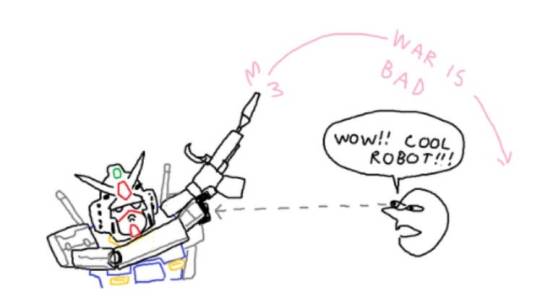
Yes, this is the original version of this meme format.
Anyway, Tomino, a renowned pacifist who grew up in the shadow of Japan's involvement in WW2 tried to use his platform as an anime director to try and tell a story that would get people to realise war's futility and brutality.
So I hear you asking, "That's nice and all, but what about the space lesbians who beat Destiel on their home turf?" Well, let's get into that.
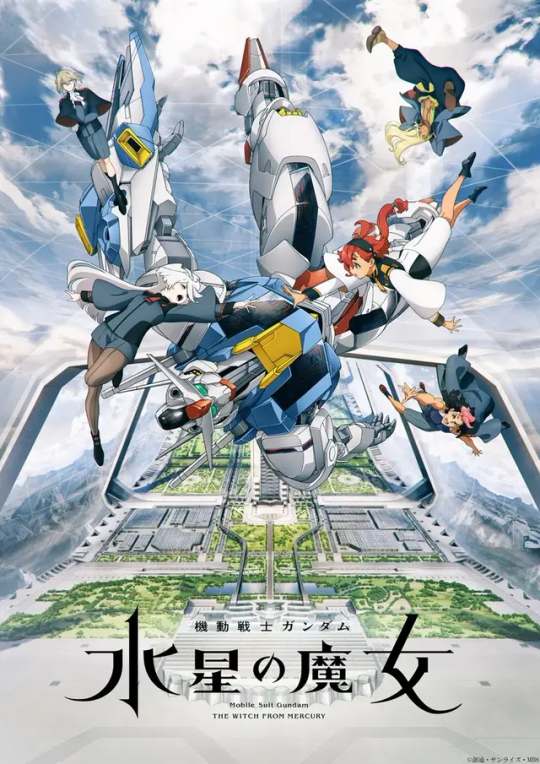
What is the Witch From Mercury?
Mobile Suit Gundam: The Witch from Mercury, or "G-Witch" for short is one of the more recent entries in the Gundam Franchise and a (very) loose adaptation of William Shakespeare's The Tempest. Set in the year 122 Ad Stella, the solar system is under the de facto control of the Benerit Group: a megacorporation with borderline-medieval internal politics that maintains a system of capitalism that benefits Spacians at the expense of those who live on Earth.
Main heroine Suletta Mercury enrolls at Asticassia School of Technology owned by the Benrit Group at the behest of her mother: CEO Prospera Mercury of the Mercury-based Shin Sei Development Corporation, and wins a Mobile Suit duel against a bully in her own MS: the Gundam Aerial. This however means she has now won the hand in marriage of daughter of the Benerit Group CEO: Miorine Rembran, beginning a series of consequences that shape the very political landscape of the solar system.
G-Witch was a massive hit, both critically and commercially. The first episode: the Witch and the Bride attracting record numbers for the studio and the Gunpla kit for the Aerial is currently the best-selling Gunpla kit ever.
Contrary to popular belief, G-Witch is not the first piece of Gundam media to feature a female protagonist. That honour would go to the 2002 Japan-only manga École du Ciel, nor would it have the first queer main character, which goes to 1999's Turn-A Gundam (and if you were to ask any fan of the series, they'd so it goes back to the very beginning). But it became notable for its lesbian representation in anime (in spite of Sunrise's attempts to downplay it, to the anger of the director, writer, producer, artists, animators, cast, fans and even their own parent company Bandai Namco who forced them to back off).
One thing I need to clarify: You don't need to have watched the original series to enjoy G-Witch. They're not even in the same continuity.
So if you're interested in the series and you've only watched G-Witch, I'll give out three recommendations for you all to enjoy:

Mobile Suit Gundam 00
Gundam 00 takes place in the year 2307 (the only series to use our own calendar), where the world is divided between three global superpowers: The Union of Free & Solar Nations (The Americas, Australia, New Zealand and Japan), the Human Reform League (China, South, East, Southeast and Central Asia) and the Advanced European Union (all of Europe, including all of Russia west of the Urals) who each control a space elevator near the equator and wage proxy-wars in Africa and the Middle-East over Earth's dwindling resources. This eventually culminates in the emergence of Celestial Being: a terrorist group consisting of Setsuna F. Seiei, Lockon Stratos, Allelujah Haptism and Tierria Erde, all of whom use powerful "Gundam" Mobile Suits and try to forcefully impose global peace on the Earth.
00 is pretty slow-paced and is more about the world than the individual characters, but said characters are really well-written, especially the characters from the three power blocs who are the de facto protagonists as they try to stop what are in their eyes a bunch of crazed terrorists preaching a hypocritical and incoherent ideology of "peace through force".
And to address the elephant in the room, this series is VERY post-9/11. Constant talks about terrorism, proxy-conflicts in the global south (especially the Middle-East), religious extremism, dwindling resources and the wars fought over them. While the franchise has always been political and of-its-time, you can just tell 00 was made in the mid-2000's. Again, it's good. But just something to keep in mind.
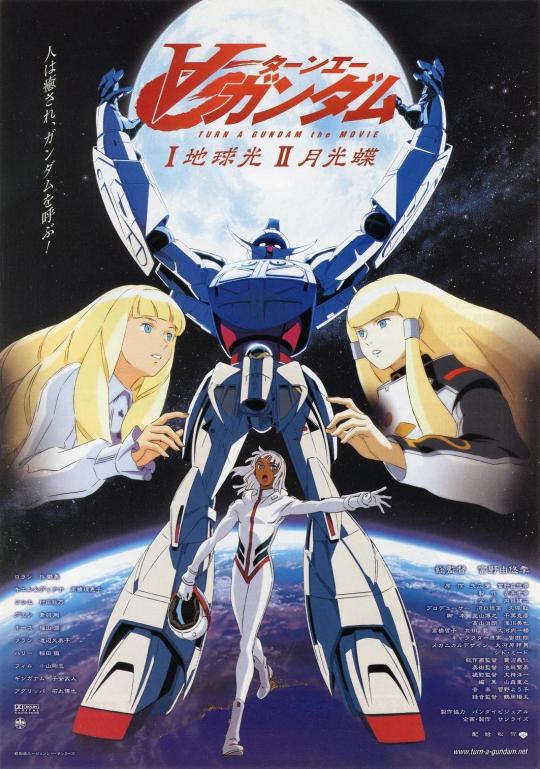
Turn-A Gundam
Turn-A Gundam is one of the weirder elements of the franchise for a myriad of reasons. Not the least of which being its unique setting taking inspiration from the famous sci-fi novel War of the Worlds.
In the Year 2345 of the Correct Century, human civilisation is at a level of technology reminiscent of the late-19th/early 20th centuries, save for the Moonrace on... well, the moon. As part of their queen Diana Soreil's plan to reintegrate both Lunar and Terran societies, several scouts are sent to the planet to set up their return to the planet. One such scout: Loran Cehack integrates into Terran society as a driver for the wealthy Heim family, though at a coming of age ceremony for the family's second daughter, a member of the Moonrace attacks the technologically-inferior Terrans. However, a mysterious mustached statue breaks apart to reveal a "White Doll": the Turn-A Gundam, allowing Loran to fend off the invaders. rest of the series becomes more of a mystery to how the supposedly-peace loving Moonrace could allow of such brutality.
The setting of the Correct Century timeline alone is one of the draws of Turn-A, though its excellent characters and compelling mystery also help a lot.
I do however have two warnings for people interested in watching it. The first is that this series was never dubbed. While it did receive an official sub in 2015, there still isn't a dub for the series. So if that bothers you, there's your warning.
The other is that there's a pretty big twist in the latter part of the series that while I will not spoil it here, it's such a big deal that I can't not mention it. It doesn't make any sense, and it actively detracts from not just the series, but the whole franchise. You'll know it when you see it. It doesn't ruin my enjoyment, but a lot of people don't like Turn-A for that alone.
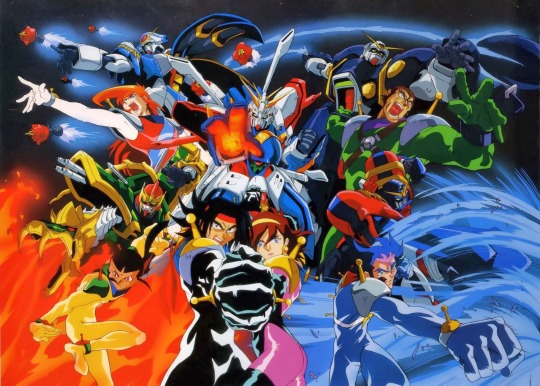
Mobile Fighter G Gundam
Favourite entry. Don't care. It's peak.
In the Year 60 of the Future Century, war has been abandoned by the nations of humanity in favour of the Gundam fight: a quad-annual fighting tournament between Gundams representative of the countries of the world where the winner rules space until the next Gundam fight, all while leaving the Earth ecologically devastated in the fighting. Neo-Japan's Gundam Fighter: Domon Kasshu arrives on Earth seeking information on his older brother Kyoji, who killed their mother and led to their father's arrest before stealing the experimental Devil Gundam to Earth, beating up every Gundam Fighter in his way. However, he eventually learns of far more dangerous revelations about the incident.
G Gundam is to put it bluntly: bat-shit insane. And I love it. It basically took a look at the then-stagnating franchise in the wake of the wet fart that was Victory Gundam and said "I know what can save this franchise, Bruce Lee movies!" And it somehow worked.
Word of advice: watch it dubbed. Mark Gatha absolutely kills it as Domon every time, and puts just the right amount of ham into every line.
So yeah, that's some stuff on Gundam. This was a long post to write out. I'm gonna take a break now.
#gundam#sulemio#g witch#destiel#ao3topshipsbracket#msg#mobile suit gundam#mobile suit gundam the witch from mercury#tumblr top ship bracket#gundam suisei no majo#supernatural#the witch from mercury#witch from mercury#history lesson
286 notes
·
View notes
Note
Hi. I used the O'Neil Cylinder diagrams in your book as inspiration for my sci-fi series. I only wish my cover was as inspirational as the covers you provided in your great book. Thank you for compiling and writing it!
Very cool! I'm always glad to see sci-fi visual history keep influencing new generations!
56 notes
·
View notes